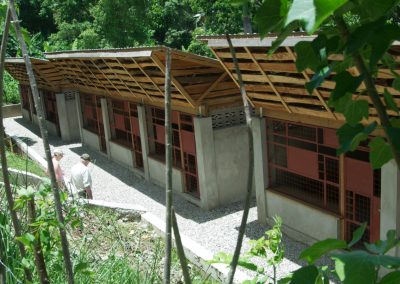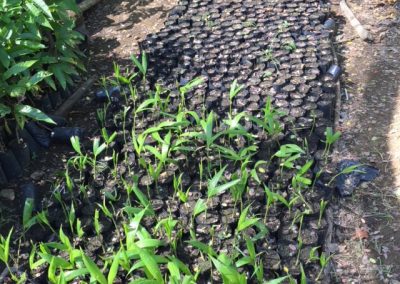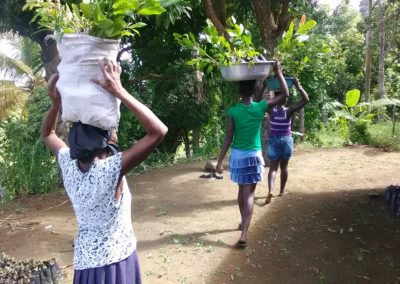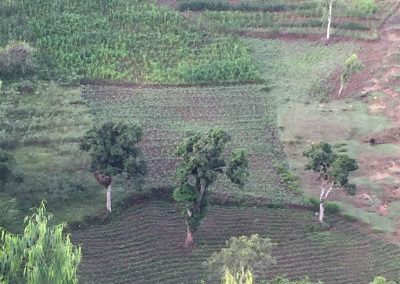The Story of Our Trees
For nearly 35 years a rural Haitian community has been reclaiming their land and their future.
Their efforts began with 40 people, and they now number almost 800.
According to the Animators, their leaders, they have planted 17.5 million trees, with over 14 million surviving despite disease, drought, and feral goats.
This community is CODEP.

Our Partner, CODEP
CODEP ‘COmprehensive DEvelopment Program’ is a loose community of rural neighborhoods, lakous. Begun in 1989 with support from Americans, CODEP has become a powerhouse of reforestation capability and performance. Over the years, the people of CODEP planted trees and that work built the skills and opportunities for their community to blossom. It now boasts a school, a micro-financing institution, various entrepreneurial enterprises, a store, and a church. Haiti Reforestation Partnership has been the US 501(c)3 entity that has provided legal cover, financial support, and expertise.
The story begins and continues with trees. Forests make all the difference. The soil is richer, the rain sinks in and when water emerges in streams, it is clear. Gardens can grow, trees produce fruit, water is cleaner, catastrophic flooding and mudslides are averted, and a more abundant life is possible.
Over half the workers of CODEP are women. Here are three women Chef Ekips — the front line managers of reforestation workers in the nurseries and fields.
APKF is just up the Jacmel Road from the Depot. It is the local store and the headquarters of the micro-financing organization from which people can borrow in order to buy or lease land for tree planting and gardens.
The Animators shoulder major leadership and decision making roles. They manage the Chef Ekips, the people who direct the teams of workers. They set direction for the organization, manage the cooperative funds, and lead projects that encourage enterprise and educate the community.
Our Animator, Rene, says that the land used to be the color of his hand – bleached out. Then CODEP started to plant trees and that changed.


A Map of our Tree Zones: One of them can even be seen
from outer space

Reforestation does not happen quickly
The work of reforestation is demanding and extended. Haiti has suffered from massive deforestation, resulting in barren landscapes and hard, rocky soil. When the rains come it turns to mud. CODEP has developed comprehensive stages of planting and growth to combat this issue:
Pepinyas | Nurseries
Recycled plastic bottles are filled with a soil mixture and seeds and then allowed to grow to seedling size in a protected area.
0—1 Year
The seedlings are transplanted from the pepinya.
1—5 Years
The saplings grow as their own leaves create further compost and nutrients. Efforts are made to protect the saplings from threats such as feral goats.
5—7 Years
Some of the trees are becoming too big to cut down and carry off. Over time the grove becomes more of a factor in anchoring the soil and retaining water.
7—25 Years
The forest grows. The increasing leaf cover allows for additional agriculture. And, the birds return!
WITH 47 NURSERIES, CODEP DEVOTES SUBSTANTIAL ENERGY TO PLANTING THE SEEDS AND NURTURING THE SEEDLINGS. WHERE DO THE SEEDS COME FROM? THEY ARE INDIVIDUALLY HARVESTED, OFTEN FROM ROTTED FRUIT IN THE MARKET, DRIED, AND STORED FOR PLANTING AT THE APPROPRIATE TIMES.
When the plan is to transplant seedlings to a hilly area, the CODEP method is to terrace the mountain side but with a specific kicker — trenches. Rows of trenches are dug to catch and hold rain water during the critical years that a seedling is taking root in the ground. The moisture from the water in the trenches improves the odds that the seedling will survive and, indeed, thrive.
Nearly 35 years old, CODEP has proven itself to be a community of committed agro-foresters. It is emerging as a major example of reforestation success in Haiti.
The hopes for the next 35 years are to share and apply its methods, seedlings, know-how, agricultural products, model of self-governance, and more to the benefit of other communities across Haiti.
